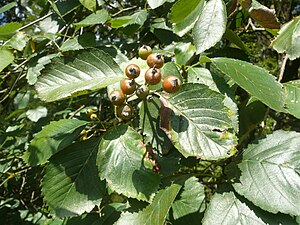Meierott's whitebeam
| Meierott's whitebeam | ||||||||||||
|---|---|---|---|---|---|---|---|---|---|---|---|---|

Meierott's whitebeam ( Sorbus meierottii ) |
||||||||||||
| Systematics | ||||||||||||
|
||||||||||||
| Scientific name | ||||||||||||
| Sorbus meierottii | ||||||||||||
| N.Mey. |
Meierotts or Wellheimer whitebeam ( Sorbus meierottii N. MEY.) Is a plant species that belongs to the complex of bastard whitebeams ( Sorbus latifolia agg.) Within the rose family ( Rosaceae ). This deciduous tree is a fixed species from a hybridization of the common whitebeam i. w. S. ( Sorbus aria s. L.) Originated with the service tree ( Sorbus torminalis ). As an agamosperm species, it reproduces asexually.
Sennikov and Kurtto have been running the species under the name Karpatiosorbus meierottii since 2017 .
description
Sorbus meierottii is a small, up to 8 m high and mainly multi-stemmed deciduous shrub or tree . The leaves are elliptical-oval, gray-green, shallowly lobed , matt on the top, and quickly coarse in summer. The leaf cut is similar to the whitebeam species of the southern Franconian Alb ( Sorbus collina M.Lepsi, P.Lepsi & N.Mey. And Sorbus danubialis (Jáv.) Kárpáti ) or Meyer's whitebeam ( Sorbus meyeri S.Hammel & Haynold ), which occurs further away in the Main-Tauber area .
The fruits that ripen in early autumn are bright red-orange to cherry-red, rounded, around 13 mm × 11.5 mm in size.
Occurrence
The species grows in the Malm step on dolomite weathering of the southern Franconian Alb on the valley flanks around the Wellheim dry valley near Konstein and Wellheim and its side valleys (Bavaria, Germany). Be settled dolomite rocks and forest edges . The whitebeam is found less often in the bushes and in poor grassland at 400–500 m above sea level.
Discovery and naming
Meierott's whitebeam was collected by Herbert Schuwerk (1935–2014) as early as 1970, initially as “ Franconian whitebeam ( Sorbus franconica Bornm. Ex Düll)”. The biologist Norbert Meyer finally found the species in 1991 on the northern edge of the Schlossberg between Konstein and Wellheim. He took a closer look at the taxon and re- described the species in 2005. Sorbus meierottii was named by Meyer after the German musicologist and botanist Lenz Meierott (born May 8, 1942).
It is one of a total of eleven local endemic small species that emerged from the hybridization of a species of the subgenus Aria (whitebeams) with the service tree only in the Franconian Alb. With the exception of Sorbus franconia , Sorbus hoppeana and Sorbus ratisbonensis, all of these species are extremely rare and restricted to a few relic sites on the edges of deciduous forests. In the interior of closed deciduous forests they are absent due to their high need for light.
literature
- N. Meyer (2016): Sorbus . In: Rothmaler, Exkursionsflora von Deutschland - Vascular Plants, Critical Supplementary Volume. - 11th ed., Pp. 113-130.
- N. Meyer, L. Meierott , H. Schuwerk, O. Angerer (2005): Contributions to the genus Sorbus in Bavaria. Special volume of the reports of the Bavarian Botanical Society, 216 pages.
- Sorbus meierottii N. MEY., Rz.uni-karlsruhe.de
- A. Sennikov, A. Kurtto: A phylogenetic checklist of Sorbus s. l. (Rosaceae) in Europe. In: Memoranda Soc. Fauna Flora Fennica 93, Helsinki 2017, pages 1-78. https://journal.fi/msff/article/view/64741
Individual evidence
- ↑ Klaus Huschik: Herbert shoe factory (1935-2014). Reports of the Bavarian Botanical Society 86, 2016, pp. 299–300. PDF file accessed on November 3, 2017
- ^ Norbert Meyer (2011): Sorbus variety in Bavaria. LWF Wissen (reports from the Bavarian State Institute for Forestry and Forestry) 67: 40-46.